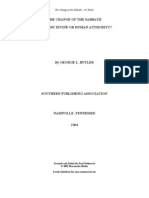كيف تتذكر القران الكريم
كيف تتذكر القران الكريم
Uploaded by
Mohammed MorganCopyright:
Available Formats
كيف تتذكر القران الكريم
كيف تتذكر القران الكريم
Uploaded by
Mohammed MorganCopyright
Available Formats
Share this document
Did you find this document useful?
Is this content inappropriate?
Copyright:
Available Formats
كيف تتذكر القران الكريم
كيف تتذكر القران الكريم
Uploaded by
Mohammed MorganCopyright:
Available Formats
Middle-East Journal of Scientific Research 13 (1): 45-48, 2013 ISSN 1990-9233 IDOSI Publications, 2013 DOI: 10.5829/idosi.mejsr.2013.13.1.
1762
Effective Techniques of Memorizing the Quran: A Study at Madrasah tahfiz Al-quran, Terengganu, Malaysia
Sedek Ariffin,1Mustaffa Abdullah, 1Ishak Suliaman, 1Khadher Ahmad, Fauzi Deraman, 1Faisal Ahmad Shah, 1Mohd Yakub Zulkifli Mohd Yusoff, 1 Monika Munirah Abd Razzak, 1Mohd Murshidi Mohd Noor, 1Jilani Touhami Meftah, 1 Ahmad K Kasar, 1Selamat Amir and 2Mohd Roslan Mohd Nor
1 1
Department of al-Quran and al-Hadith, Academy of Islamic Studies, University of Malaya, 50603 Kuala Lumpur, Malaysia 2 Department of Islamic History and Civilization, Academy of Islamic Studies, University of Malaya, 50603 Kuala Lumpur, Malaysia
Abstract: Until today, memorization is still one of the methods used in the process of preservation of al-Quran. This article aims to review and analyze the methods and approaches used by a Centre of Tahfiz al-Quran, namely Madrasah Quran, Terengganu, Malaysia in the process to produce the students that can memorize the whole al-Quran. This study used the methods of documentation, observation and interviews in order to obtain the data. Through the analysis, this study found that there are four basic methods of memorizing al-Quran. The methods are Sabak method, Para Sabak, Ammokhtar and Halaqah Dauri. By using these four methods, the students could recite the whole Quran by memorization, within 15 hours without seeing the mushaf. These methods of memorization could be applied in all Quranic memorization centers in order to produce the huffaz who can fully remember the whole Quran. Key words: Memorization of Al-Quran % Methodology of Memorization % Tahfiz Al-Quran % Huffaz % Malaysia INTRODUCTION Memorizing is one of the techniques used by ancient scholars in preserving knowledge, especially in the preservation of the Quran. There is no doubt that in this modern age there are many methods used to ensure the reservation of al-Quran. However, memorizing method is still used to ensure that the Qur'an remains intact in the hearts of its followers. This approach is fortified with a variety of rewards will be given by Allah for those who memorize the Quran. It is found through many of the saying by the Prophet Muhammad s.a.w. Memorizing the Quran is not an easy thing to be done by every Muslim. Quran memorization process requires the person to have some skills beforehand; that was to recite Quran well, with proper tajwid [1] and smooth reading. Only then someone began to memorize the Quran. To produce a good and strong memorization and be able to remember all 30 juzu of the Quran, the Muslim individual must follow the specific rules to ensure his memorization is really stick well in his mind. This study was conducted to uncover the methods used in Madrasah Tahfiz al-Quran Kubang Bujuk, Terengganu Malaysia. The students in this school are able to read 30 juzu of the Quran by memorizing, from 5.00 am and will be end at 10 pm [2]. The students will only have a short break to perform their prayers and take some food and drinks. On the average, the students will take around 15 hours to recite 30 juzu of the Quran by memorizing. This means that the students will take about 30 minutes to read a juzu of the Qur'an and the whole 15 hours is equivalent to all 30 juzu of the Qur'an [2].
Corresponding Author: Sedek Ariffin, Department of al-Quran and al-Hadith, Academy of Islamic Studies, University of Malaya, 50603 Kuala Lumpur, Malaysia. Mob: +60192706510, Tel: (Off): +60379676010.
45
Middle-East J. Sci. Res., 13 (1): 45-48, 2013
MATERIALS AND METHODS In completing this study, three methods were used to obtain the relevant materials with the objectivity of the study. These methods are the method of documentation, observation and interviews. Through these three methods, the findings will be compiled and analyzed precisely. Documentation method is used to obtain data related to Madrasah Tahfiz al-Quran Kubang Bujuk. This method is also to obtain the figures related to the number of students who have recited 30 juzu of Quran in one day; that was equal to 15 hours of memorization and recitation. Observation method is used to identify the approach and techniques used by the school in order to produce the hafiz who can recite the Quran by memorizing, in 15 hours without seeing the mushaf of the Qur'an. Interview method was used to interview the students and teachers at this school for their views related to the techniques used in this institution. RESULTS Based on the analysis made, there are four basic methods used in Madrasah Tahfiz al-Quran Kubang Bujuk. The method was named as Sabak, Para Sabak, Ammokhtar dan Halaqah Dauri[5]. By practicing this method, the student can read all 30 juzuby memorization, without looking at the Mushaf of al-Quran [3]. Sabak is a term used in this school to describe a new memorization of the students. Each new verses being recited to the teacher referred as sabak [5]. The students are required to memorize based on their ability. They start from half of page, until they reach approximately four pages of Quran Rasm Uthmani. Normally, the students will memorize about one to two pages only. For students who are weaker, they will memorize about only half of page [2]. Through this technique, the students are required to memorize verse after verse up to the point specified by the teacher. To start memorizing, the students will begin to memorize from juzu30,then followed by juzu 29,28,27 and 26 respectively and only then the students will start memorizing from the front, that was juzu 1 up until juzu 25 [5]. This will make it easier for students because the last five juzu have shorter verses, simple and most of the verses are common verses (Ar. Ayah Lazim)[7]. In this method, the students are required to launch a repeated reading of verses as much as 40 times before they memorized in particular. This is very important to 46
ensure that the student can excellently pronounce the verses and thus later facilitate the memorization of the Qur'an. According to Ustaz Hasbullah [2] after reading for 40 times with mushaf, the students need only a short time to transfer the verses into their memory. Before they recite their memorization to the teachers in the group, they are required to recite first with their friends on their side. This is to ensure that the readings are accurate and correct with the verses of the Qur'an [8]. In addition, it was to improve the smoothness of the memorization when they read in front of their teachers. The students were told to read more than 10 times [2]. For students who are ready to recite their memorization, they will sit in front of the teacher. Teachers will record their progress in special books. On the whole, the students have about four hours to memorize starting from 5.00 am until 9.00 am. This shows that the students have a long time in ensuring that new verses being memorized really well and will remain in their hearts [9]. The second stage in this method is called as Para Sabak. Para Sabak is read by recite one juzu in the back of the new memorization (sabak) [5]. It is also termed as weekly memorization. Para Sabak is starting from 9.30 am until 11.30 am. The student is allocated about two hours to review and repeat Para Sabak[2]. The students need to smooth this Para Sabak recitation before being read in front of their teachers [10]. Students are usually given about half an hour before being recited in front of the teachers. In carrying out this stage, the teachers divided the students with their partners. Normally the pair is in the same level, or nearly the same level. It is important to ensure compatibility between them [9]. Next, all the students and also their partners will be called to sit oppositely, in front of the teachers of the groups. A student will read a juzu and his partner will check for the reading by looking at mushaf. The partner will calculate for the number of mistakes and after that it will be reported to the teacher [10]. The process continues with the other person. In the same time, the teachers of the group are constantly watching for the progress to run smoothly. Normally the number of students in each group is in round numbers, in order to facilitate the Para Sabak with their partners [9]. The third stage of this method is known as Ammokhtar. Ammokhtar is the verses of the Quran that had been memorized and they are more than one juzu in the back of recent verses [5]. According to this method, the students will be given time from 2.30 pm to 4.00 pm for repeating of Ammokhtar [3].
Middle-East J. Sci. Res., 13 (1): 45-48, 2013
In terms of implementation, the students will be given about half an hour to run Ammokhtar reading before being called in front of the teacher, as in the method of Para Sabak in order to recite the verses together with their partners [7]. Usually, the teacher will determine whether they will have the same partners or different partners. And as usual, the canning stimulus will be given if the students did forget or make mistakes in the reading. Ammokhtar method should be in a full round of all the past memorization of verses / juzu. Every day, the students are required to read a juzu of this Ammokhtar. For example, if a student is to memorize the juzu of 15, so he needs another 14 days with a rate of one juzu a day reading Ammokhtar. Ammokhtar reading should be in the order and actual arrangement of the Qur'an [2]. This is very important to ensure that the memorization is not easily lost from the memory of the students [3]. The next technique which is the last technique is Halaqah Dauri. Halaqah Dauri is a group that involved the students that already finished memorizing the whole Quran [5]. All the students who completed their memorization will enter this Halaqah Dauri in order to repeat the verses that have been memorized. It will be monitored by a teacher that ensures all students repeated their memorization as being planned [2]. Normally, the students will take from six months up until two years to go through this whole Halaqah Dauri [3]. For the students who do not fluent at any part in the Quran, they are required to read the verses by Sabak technique once again. For this Halaqah Dauri, the students will not read the juzu in the exact order [6]. The whole of the Qur'an will be divided into three parts. The first 10juzu, the second 10 juzu and and the final 10juzu [5]. The first day, the students will read the first juzu. The second day, they will read the 11th juzu and the 21st juzu for the third day. As for the fourth day, they will go back to the first part that was the second juzu, the 12th juzu for the fifth day and so forth until they complete the reading for several times [2]. The method of Halaqah Dauri is also similar to Ammokhtar, where the students will be divided into pairs and being recited in front of teachers. The teachers in Halaqah Dauri will monitor the performance of the students. From a juzu a day, the students will speed to three juzu a day, with the instructions from the teachers. The students will read the first juzu, the 11th juzuand also the 21st juzu and then for the next day, they will recite the second juzu, the 12 juzu and also the 22 juzu.This will continue until the students are doing really well [3].
Following the teachers instructions, the students will move to the level of five juzu per day. At this level, the students will read the complete sequence of the Quran. The first day, they will read the first juzu until the fifth juzu. The second day, they will read the juzu of 6 to 10 and the third day will be the juzu of 11 to 15 and will continue until the 30 juzu. This means that the students will recite the whole Qur'an in six days [2]. Having reached to this level and the teachers are satisfied with their performance, the final examination will be held to these students [3]. The students will recite by memorization all the 30 juzu of the Quran without mushaf starting from 5.00 am and finish the recitation at 10.00 pm [2]. On average, the students will take about 30 minutes to read a juzu and takes about 15 hours for the entire 30 juzu of the Qur'an. The students will take some short breaks; only to perform the prayers and take the light foods and drinks. The memorization test will be monitored by three teachers and the students cannot do mistakes for more than 10 times for all 30 juzu being recited [2]. If the student committed the mistakes for more than 10 times, this test will be canceled and the student is asked to re-enter the Halaqah Dauri [5]. Based on information from the school, there are 137 students who attended this method properly and successfully within 2005-2011 [4]. According to the observations, the result from the implementation of this method is that the students are able to remember/memorize the whole Qur'an properly. The students memorization and their resistance are also strong and good. Based on interviews conducted, the teachers and the students [6, 11, 12, 13] said that after using this method, though they not to repeat for a year, they still managed to become an imam for tarawih prayers and still can read all 30 juzu of the Qur'an properly [14]. As a result of observation, this is where the strength of this method lies, which can produce the hafiz of the Qur'an with strong memories [15]. CONCLUSION As a result from this study, these four methods that have been applied at the Madrasah Tahfiz al-Quran Kubang Bujuk, Terengganu, Malaysia should be used as a reference by each institution that related to memorization of the Qur'an. Methods applied in this school should be practiced in other tahfiz centers. These can be the best role models in the production of huffaz that can remember the whole Quran in a short
47
Middle-East J. Sci. Res., 13 (1): 45-48, 2013
period of time. The ability to read all 30 juzu of the Qur'an in 15 hours by heart proves that this method is very suitable for any Tahfiz Quran institutions. REFERENCES 1. Yahya, S.A.B., 1994. Al-Tibyan fi Adab Hamlah al-Quran. Damsyik, Beirut. Maktabah Dar al-Muayyad, pp: 16. Interviews with principals of Madrasah Tahfiz al-Quran, Kubang Bujuk, Terengganu, Malaysia, Ustaz Hasbullah Abdullah on January, 15: 2012. Interviews with Senior Teacher, Madrasah Tahfiz al-Quran, Kubang Bujuk, Terengganu, Malaysia, Ustaz Zakri Zamzam on January, 16: 2012. Ahmad, K., 2006. Daftar al-Hudur. Pusat Madrasah. pp: 3-9. Muhammad, A., 2005. Panduan Menghafal al-Quran, Kuala Terengganu. Pusat Madrasah, pp: 12-26. Interviews with head students of Madrasah Tahfiz al-Quran, Kubang Bujuk, Terengganu, Malaysia. Muhammad Fathi Khalil on January, 15: 2012. Interviews with Senior Teacher, Madrasah Tahfiz al-Quran, Kubang Bujuk, Terengganu, Malaysia, Khairuddin Ahmad on January, 16: 2012. Interviews with Senior Teacher, Madrasah Tahfiz al-Quran, Kubang Bujuk, Terengganu, Malaysia, Ali Zainal Abidin on January, 16: 2012.
9.
10.
11.
2.
12.
3.
13.
4. 5. 6.
14.
15.
7.
Interviews with Senior Teacher, Madrasah Tahfiz al-Quran, Kubang Bujuk, Terengganu, Malaysia, Yusof Akhbar on January, 16: 2012. Interviews with Senior Teacher, Madrasah Tahfiz al-Quran, Kubang Bujuk, Terengganu, Malaysia, Fahad Mohd Ali on January, 16: 2012. Interviews with students of Madrasah Tahfiz al-Quran, Kubang Bujuk, Terengganu, Malaysia. Muhammad Khairi Jalil on January, 16: 2012. Interviews with students of Madrasah Tahfiz al-Quran, Kubang Bujuk, Terengganu, Malaysia. Jahidi Khalid on January, 14: 2012. Interviews with students of Madrasah Tahfiz al-Quran, Kubang Bujuk, Terengganu, Malaysia. Muhammad Kamarulzaman Ariffin on January, 13: 2012. Sedek, A., Kaedah Menghafal al-Quran Di Institusi Tahfiz al-Quran Di Malaysia: Kajian Perbandingan Antara Kaedah Darul Quran dan Kaedah al-Huffaz, Theses Ph.D University of Malaya, 103: 2012. Sedek, A., Kaedah Menghafal al-Quran Di Institusi Tahfiz al-Quran Di Malaysia: Kajian Perbandingan Antara Kaedah Darul Quran dan Kaedah al-Huffaz, Theses Ph.D University of Malaya, 99: 2012.
8.
48
You might also like
- The Subtle Art of Not Giving a F*ck: A Counterintuitive Approach to Living a Good LifeFrom EverandThe Subtle Art of Not Giving a F*ck: A Counterintuitive Approach to Living a Good LifeRating: 4 out of 5 stars4/5 (5936)
- The Gifts of Imperfection: Let Go of Who You Think You're Supposed to Be and Embrace Who You AreFrom EverandThe Gifts of Imperfection: Let Go of Who You Think You're Supposed to Be and Embrace Who You AreRating: 4 out of 5 stars4/5 (1107)
- Never Split the Difference: Negotiating As If Your Life Depended On ItFrom EverandNever Split the Difference: Negotiating As If Your Life Depended On ItRating: 4.5 out of 5 stars4.5/5 (886)
- Grit: The Power of Passion and PerseveranceFrom EverandGrit: The Power of Passion and PerseveranceRating: 4 out of 5 stars4/5 (598)
- Hidden Figures: The American Dream and the Untold Story of the Black Women Mathematicians Who Helped Win the Space RaceFrom EverandHidden Figures: The American Dream and the Untold Story of the Black Women Mathematicians Who Helped Win the Space RaceRating: 4 out of 5 stars4/5 (925)
- Shoe Dog: A Memoir by the Creator of NikeFrom EverandShoe Dog: A Memoir by the Creator of NikeRating: 4.5 out of 5 stars4.5/5 (545)
- The Hard Thing About Hard Things: Building a Business When There Are No Easy AnswersFrom EverandThe Hard Thing About Hard Things: Building a Business When There Are No Easy AnswersRating: 4.5 out of 5 stars4.5/5 (353)
- Elon Musk: Tesla, SpaceX, and the Quest for a Fantastic FutureFrom EverandElon Musk: Tesla, SpaceX, and the Quest for a Fantastic FutureRating: 4.5 out of 5 stars4.5/5 (476)
- Her Body and Other Parties: StoriesFrom EverandHer Body and Other Parties: StoriesRating: 4 out of 5 stars4/5 (831)
- The Emperor of All Maladies: A Biography of CancerFrom EverandThe Emperor of All Maladies: A Biography of CancerRating: 4.5 out of 5 stars4.5/5 (274)
- The World Is Flat 3.0: A Brief History of the Twenty-first CenturyFrom EverandThe World Is Flat 3.0: A Brief History of the Twenty-first CenturyRating: 3.5 out of 5 stars3.5/5 (2272)
- The Little Book of Hygge: Danish Secrets to Happy LivingFrom EverandThe Little Book of Hygge: Danish Secrets to Happy LivingRating: 3.5 out of 5 stars3.5/5 (419)
- The Yellow House: A Memoir (2019 National Book Award Winner)From EverandThe Yellow House: A Memoir (2019 National Book Award Winner)Rating: 4 out of 5 stars4/5 (99)
- Devil in the Grove: Thurgood Marshall, the Groveland Boys, and the Dawn of a New AmericaFrom EverandDevil in the Grove: Thurgood Marshall, the Groveland Boys, and the Dawn of a New AmericaRating: 4.5 out of 5 stars4.5/5 (270)
- The Sympathizer: A Novel (Pulitzer Prize for Fiction)From EverandThe Sympathizer: A Novel (Pulitzer Prize for Fiction)Rating: 4.5 out of 5 stars4.5/5 (122)
- NAPF-1-Guide Pédagolgique PDFDocument84 pagesNAPF-1-Guide Pédagolgique PDFrakhee sachdevNo ratings yet
- Team of Rivals: The Political Genius of Abraham LincolnFrom EverandTeam of Rivals: The Political Genius of Abraham LincolnRating: 4.5 out of 5 stars4.5/5 (235)
- A Heartbreaking Work Of Staggering Genius: A Memoir Based on a True StoryFrom EverandA Heartbreaking Work Of Staggering Genius: A Memoir Based on a True StoryRating: 3.5 out of 5 stars3.5/5 (232)
- On Fire: The (Burning) Case for a Green New DealFrom EverandOn Fire: The (Burning) Case for a Green New DealRating: 4 out of 5 stars4/5 (75)
- The Unwinding: An Inner History of the New AmericaFrom EverandThe Unwinding: An Inner History of the New AmericaRating: 4 out of 5 stars4/5 (45)
- Role Audience Format Topic: THREE FACTS From The Notes and The Movie (You Must Include at LeastDocument2 pagesRole Audience Format Topic: THREE FACTS From The Notes and The Movie (You Must Include at LeastAvery GerosaNo ratings yet
- Electrical Design of Commercial and Industrial BuildingsDocument20 pagesElectrical Design of Commercial and Industrial BuildingsSahil Khan33% (6)
- Vampire Queen Book 01 - 06 by Joey W. HillDocument3 pagesVampire Queen Book 01 - 06 by Joey W. Hilltopmix82No ratings yet
- Surprises: by Liza CharlesworthDocument10 pagesSurprises: by Liza CharlesworthLivegreen 360No ratings yet
- Book New Proposal FormDocument3 pagesBook New Proposal FormopurataNo ratings yet
- Challenge 1 Weekly Planner Semester 1 2022 2023 DottmanDocument36 pagesChallenge 1 Weekly Planner Semester 1 2022 2023 DottmanAlyssa S100% (1)
- You've Got Issues: James - Lesson 1 WorkbookDocument10 pagesYou've Got Issues: James - Lesson 1 WorkbookTassy Michelle MuchabaiwaNo ratings yet
- SCI PUBLICATION P387 Steel Building Desi PDFDocument106 pagesSCI PUBLICATION P387 Steel Building Desi PDFSabarishwaran SabariNo ratings yet
- Avi Book ListDocument2 pagesAvi Book ListLarryNo ratings yet
- Sujay Sood-"Dharmic-ethics" The Ethical Sociality of The Self in Postmodernism and Post-ColonialismDocument240 pagesSujay Sood-"Dharmic-ethics" The Ethical Sociality of The Self in Postmodernism and Post-ColonialismFelix WoelflinNo ratings yet
- Winter Wonderland 17 Winter Patterns To Crochet PDFDocument65 pagesWinter Wonderland 17 Winter Patterns To Crochet PDFinformatica.paula6988100% (2)
- Change of The Sabbath - ButlerDocument84 pagesChange of The Sabbath - ButlerHaSophimNo ratings yet
- The Pinocchio EffectDocument1 pageThe Pinocchio EffecthenrikdiamantNo ratings yet
- Reference Examples - Quick Guide: APA Style 7th EditionDocument29 pagesReference Examples - Quick Guide: APA Style 7th EditionDan BeaNo ratings yet
- Summative in EnglishDocument29 pagesSummative in EnglishmerianneangelfNo ratings yet
- Genesis PresentationDocument2 pagesGenesis PresentationSrikar VaradarajNo ratings yet
- The Science of New Testament Textual Criticism by Periander EsplanaDocument49 pagesThe Science of New Testament Textual Criticism by Periander EsplanaperixmindNo ratings yet
- Review: Istvan Csicsery-Ronay Jr.'s The Seven Beauties of Science Fiction, Por Paul KincaidDocument5 pagesReview: Istvan Csicsery-Ronay Jr.'s The Seven Beauties of Science Fiction, Por Paul KincaidFelipe BorgesNo ratings yet
- QuotesDocument2 pagesQuotesOlaru Vrajeala Penala Catalin-MihailNo ratings yet
- Dash and The Smushy BusDocument6 pagesDash and The Smushy Busapi-350095594No ratings yet
- Harry PotterDocument5 pagesHarry PotterBogdan-Ilie NovacNo ratings yet
- JCR Vol. 12 No. 02: Symposium On The Biblical Text and LiteratureDocument424 pagesJCR Vol. 12 No. 02: Symposium On The Biblical Text and LiteratureChalcedon Foundation100% (8)
- History - Print Culture and The Modern World 01 - Class Notes - (10th Board Booster 2024)Document18 pagesHistory - Print Culture and The Modern World 01 - Class Notes - (10th Board Booster 2024)P jena Kumar100% (1)
- 23 BibliographyDocument4 pages23 BibliographyLugiek XanadutiaNo ratings yet
- Al-Āmidī's Al-Muwāzana and The Size of Knowledge: Julia BrayDocument24 pagesAl-Āmidī's Al-Muwāzana and The Size of Knowledge: Julia BrayM.TahaNo ratings yet
- The Mists of Akuma - PrimerDocument14 pagesThe Mists of Akuma - PrimerJohn FastNo ratings yet
- N L C V: Aus: Zeitschrift Für Papyrologie Und Epigraphik 117 (1997) 210-212 © Dr. Rudolf Habelt GMBH, BonnDocument4 pagesN L C V: Aus: Zeitschrift Für Papyrologie Und Epigraphik 117 (1997) 210-212 © Dr. Rudolf Habelt GMBH, BonnNourhanMagdyNo ratings yet
- Soal Ulangan Harian Banner Poster PamphlDocument4 pagesSoal Ulangan Harian Banner Poster PamphlFahri Ray50% (6)
- The Fundamentals of Typography PDFDocument202 pagesThe Fundamentals of Typography PDFCésar NunesNo ratings yet






































































